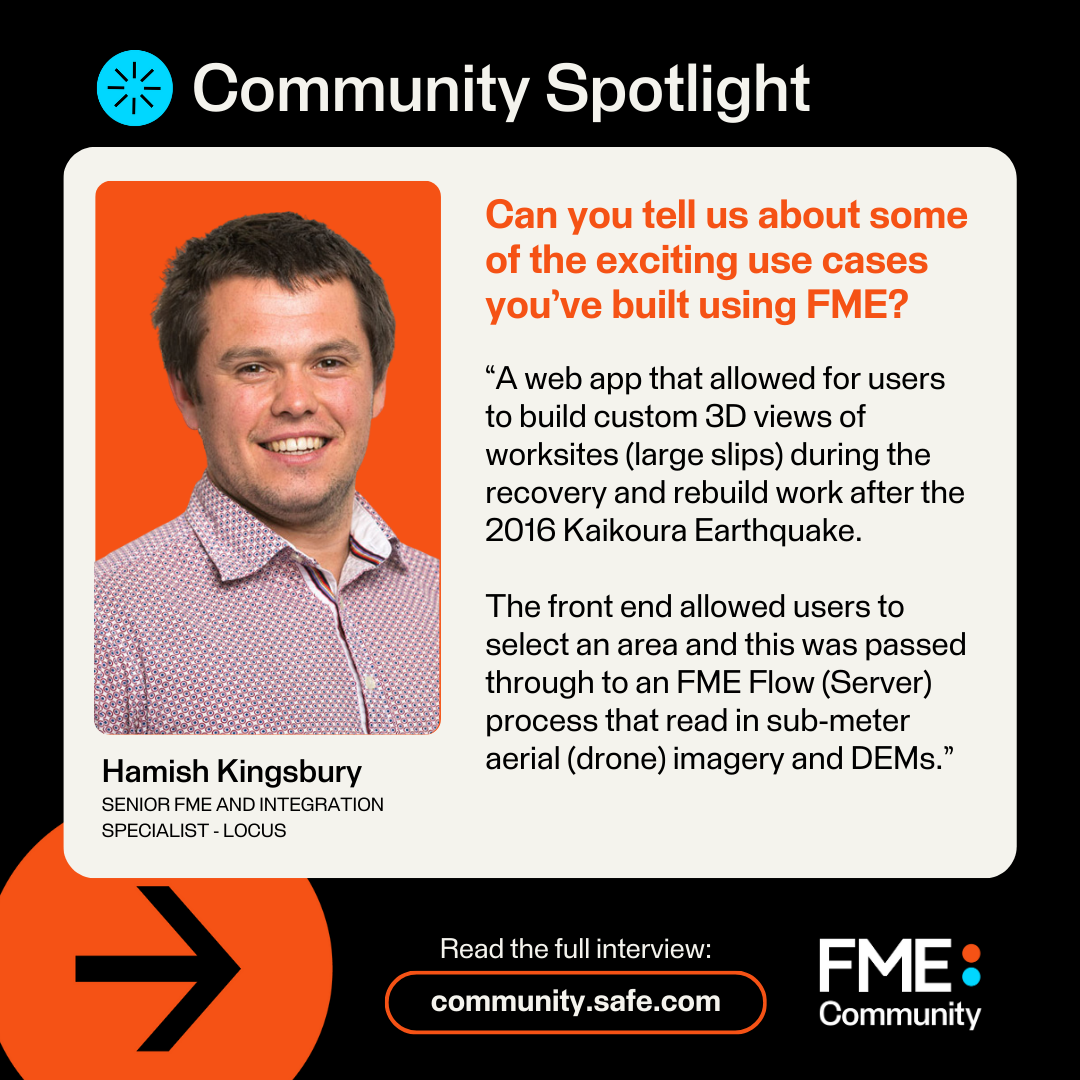Welcome to our November FME Community User Spotlight! Every month, we’ll be spotlighting a user in the community whose active participation and helpful contributions have been invaluable to the community. We’re excited to highlight their experiences and insights!
User Spotlight: Hamish Kingsbury @hkingsbury
What’s your name?
Hamish Kingsbury
What company do you currently work for?
Locus
What’s your current job role and title?
Senior FME and Integration Specialist
Tell us more about what you do and how you use FME?
I initially started using FME as an alternative to Ersi Model Builder, so I began with a lot of GIS and spatial data.
As time progressed, I began to move more into the infrastructure and enterprise side of FME. I tend to use FME for a wide range of things, including simple and complex GIS, monitoring and management of other enterprise systems, and (non-spatial) data and system integration.
One key thing I like to remember is that spatial data is just data, with a couple of extra fields that specify a location. So whilst FME has a large user base from spatial, all the tools can be used for non-spatial data as well.
Why did you join the FME Community?
To help foster growth in FME, it's awesome seeing so many new people come along and ask interesting questions and then going on to see them participate and gain confidence to answer them as well.
It's also helped me connect with other FME users from across the world! Meeting them in person at the international conferences is great. You already feel like you know them by just seeing them active on the community.
What tips do you have for users on how to get the most out of the FME Community?
Take part, get involved and ask questions, no question is too simple or too complex!
When you ask a question, try to include examples of what you have, an example of what you want, and any screenshots of what you're currently doing. If possible, even include some sample data.
The more information you provide, the faster and better the response will be.
Tell us about some of the exciting use cases you’ve built using FME.
Gosh, I could write a lot here! Three that really stand out for me are:
1) An FME process that utilizes ArcGIS Tokens to authenticate and allow access to FME processes. This allowed for users to be managed on the Esri side and then be allowed access to FME processes through various web applications. The FME process is anonymous and requires the front end to pass through a valid Esri token, workspace to run, and the workspace parameters. If these are valid, it returns an FME Job ID that can then be queried via a second anonymous workspace. The wider process also supported file uploads, data streaming, and data downloads.
2) A web app that allowed for users to build custom 3D views of worksites (large slips) during the recovery and rebuild work after the 2016 Kaikoura Earthquake.
The front end allowed users to select an area and this was passed through to an FME Flow (Server) process that read in sub-meter aerial (drone) imagery and DEMs. Data was then compiled into a format that was read by a custom Three.js web app. This web app could also then be switched between various dates to see how earthworks progressed over time.
3) I’ve also got a bit of a different use case of FME. I participate in a sport called powerlifting, which is the squat, bench press, and deadlift (not to be confused with Olympic lifting, which is the snatch and the clean and jerk). I’m also on the local committee who are responsible for organizing and running meets (amongst other things).
When I joined the committee a few years ago, there was a very manual process of transcribing entries from a platform called Sporty to the meet software OpenLifter and various required paper scorecards and record keeping. Of course I looked at this and realized that a tool like FME would be able to help streamline, standardize, and generally improve the process!
Within a couple of hours, I had a process setup to import the entries into OpenLifter. After a couple of hours of more work (involving setting up Microsoft Word templates), I had all the other processes fleshed out and ultimately turned a half day job into something that took a couple of minutes to run! I did unfortunately have to build the process in Python so I could distribute it out to the other committee members, but FME was key in developing the solution.
What’s one of your favourite tips or tricks for using FME?
Jokingly, square connection paths slow down your features because they have to stop at the right angles #StraightConnectionPathBestConnectionPath
In all seriousness, just try things. Two things that I really like about FME are:
1) Your source data doesn't change if you don't have a (feature)writer in your workspace. There are some exceptions to this, but generally you're fine to just try a transformer and see what it does.
2) There are often multiple ways to solve a problem, each having their own (dis)advantage. If you give a problem to two FME users, you'll often find you get three (or more!) solutions.
3) And a third bonus one; treat datetimes as spatial geometry. If you have a time window and want to see what events fall within a range, firstly convert your datetimes to epoch (seconds that count up from 1/1/1970) then, use a vertexreplacer and convert single events to points (y=0, x=epoch) and ranges to lines. Then you can use spatial operations to figure out when things happened!
If you were stranded on an island and could only bring three things with you, what would they be?
An emergency locator beacon, a decent hunting knife, and a water purifier
If you could work from anywhere in the world, where would it be?
That's a really tough one, I love Christchurch, NZ (my home town) as it is close to everything. But there are two places that would be awesome to work from, for totally different reasons!
First, would be on a high country farm in the central South Island - amazing views, beautiful clean air, quiet and serene. Another would be London, the hustle and bustle, so much to see and do, so many different food options, fantastic public transport.
However, I’m sure I’d always find reasons to not like where I work from!












